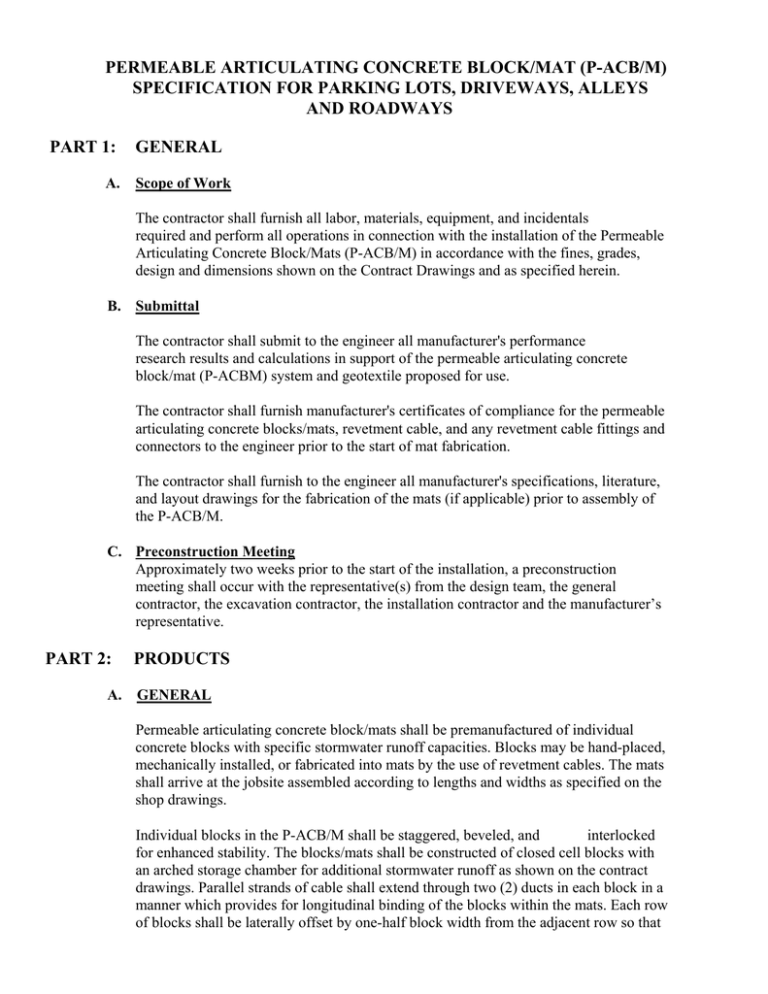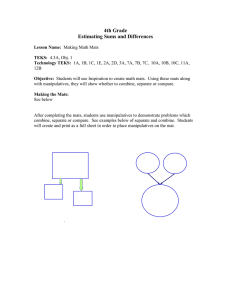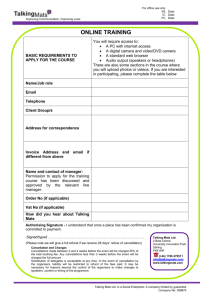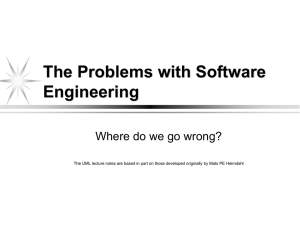INFIL Spec.
advertisement

PERMEABLE ARTICULATING CONCRETE BLOCK/MAT (P-ACB/M) SPECIFICATION FOR PARKING LOTS, DRIVEWAYS, ALLEYS AND ROADWAYS PART 1: A. GENERAL Scope of Work The contractor shall furnish all labor, materials, equipment, and incidentals required and perform all operations in connection with the installation of the Permeable Articulating Concrete Block/Mats (P-ACB/M) in accordance with the fines, grades, design and dimensions shown on the Contract Drawings and as specified herein. B. Submittal The contractor shall submit to the engineer all manufacturer's performance research results and calculations in support of the permeable articulating concrete block/mat (P-ACBM) system and geotextile proposed for use. The contractor shall furnish manufacturer's certificates of compliance for the permeable articulating concrete blocks/mats, revetment cable, and any revetment cable fittings and connectors to the engineer prior to the start of mat fabrication. The contractor shall furnish to the engineer all manufacturer's specifications, literature, and layout drawings for the fabrication of the mats (if applicable) prior to assembly of the P-ACB/M. C. Preconstruction Meeting Approximately two weeks prior to the start of the installation, a preconstruction meeting shall occur with the representative(s) from the design team, the general contractor, the excavation contractor, the installation contractor and the manufacturer’s representative. PART 2: A. PRODUCTS GENERAL Permeable articulating concrete block/mats shall be premanufactured of individual concrete blocks with specific stormwater runoff capacities. Blocks may be hand-placed, mechanically installed, or fabricated into mats by the use of revetment cables. The mats shall arrive at the jobsite assembled according to lengths and widths as specified on the shop drawings. Individual blocks in the P-ACB/M shall be staggered, beveled, and interlocked for enhanced stability. The blocks/mats shall be constructed of closed cell blocks with an arched storage chamber for additional stormwater runoff as shown on the contract drawings. Parallel strands of cable shall extend through two (2) ducts in each block in a manner which provides for longitudinal binding of the blocks within the mats. Each row of blocks shall be laterally offset by one-half block width from the adjacent row so that any given block is interlocked and cabled to four other blocks (two in the row above and two in the row below). Six adjacent blocks shall also surround each block. Each block shall incorporate interlocking surfaces that prevent lateral displacement of the blocks within the mats when they are lifted by the longitudinal revetment cables. The interlocking surfaces must not protrude beyond the perimeter of the blocks to such an extent that they reduce the flexibility or articulating capability of the articulating concrete mats or become damaged or broken when the mats are lifted during shipment or placement. Once the mats are in place, the interlocking surfaces shall prevent the lateral displacement of the blocks even if the cables should become damaged or removed. The mats must be able to flex a minimum of 10 degrees between any given row and column of blocks in the uplift direction. The cables shall be inserted into the mats in such a manner to form lifting loops at one end of the mat with the corresponding cable ends spliced together to form a lifting loop at the other end of the mat with sleeves approved by the engineer. Infiltration Performance: The P-ACB/M will only be accepted when accompanied by documented third party infiltration performance characteristics based on ASTM C1701/C1701M-09, or C1781. The infiltration rate shall be no less than 1,500 inches per hour on an outdoor working surface, with typical base material utilized for the test. Structural Performance: The design of the P-ACB/M shall be capable of supporting AASHTO H-25 and HS-25 truck loading. The blocks should be analyzed as unreinforced concrete arches supporting a uniform truck tire load with impact per AASHTO standards. As with all vehicular traffic paving systems, the subgrade soil, geosynthetic and base preperation for the P-ACB/M must be properly designed and prepared. This is critical to the performance of the system. B. Cellular Concrete Blocks 1. Materials 1.1 Cementitious Materials – Materials shall conform to the following applicable ASTM specifications: 1.1.1 Portland Cements - Specification C 150, for Portland Cement. 1.1.2 Blended Cements - Specification C 595, for Blended Hydraulic Cements. 1.1.3 Hydrated Lime Types - Specification C 207, for Hydrated Lime Types. 1.1.4 Pozzolans - Specifications C 618, for Fly Ash and Raw or Calcinated Natural Pozzolans for use in Portland Cement Concrete. 1.2 Aggregates shall conform to the following ASTM specifications, except that grading requirements shall not necessarily apply: 1.2.1 Normal Weight - Specification C 33, for Concrete Aggregates. 2. Physical Requirements 2.1 At the time of delivery to the work site, the units shall conform to the physical requirements prescribed below. TABLE 1: PHYSICAL CHARACTERISTICS Item Dimensions Description Length x Width x Height Compressive Strength ASTM D‐6684 / C‐140 Block Weight Loading Capabilities Joint Filler Between Blocks Percent Open Space Water Absorption (%) Density (lbs/cf) Storage Capacity Post‐Installation, Verified Surface Infiltration Rate Truck Load Traffic Rating Material Used ASTM D‐6684 Table 1 / ASTM C‐ 140 Above Aggregate Within Arch ASTM C1701/C1701M‐09 ASTM C1781 Values 12” x 12” x 5.65” (+/‐ 1/8”) Avg. of Three: 4,000 psi min. Individual units: 3,500 psi min. Arched Block: 45‐50 lbs/sf Solid Block: 55‐60 lbs/sf AASHTO H‐20, HS‐20, HS‐25 NONE Required Surface: 7% Storage: 20% 9.1% Avg. of Three, 11.7% Individual 130 Avg of Three, 125 Individual 0.0833 cf/block Ave of three tests: 1,500 inches/hour/sf (MIN. 3 tests) 3. Visual Inspection 3.1 All units shall be sound and free of defects that would interfere with the proper placing of the unit or impair the strength or permanence of the construction. Surface cracks incidental to the usual methods of manufacture, or surface chipping resulting from customary methods of handling in shipment and delivery, shall not be deemed grounds for rejection. Cracks exceeding 0.25 inches in width and/or 1.0 inch in depth shall be deemed grounds for rejection. 4. Sampling and Testing 4.1 The purchaser or his authorized representative shall be accorded proper access to the manufacturer to inspect and sample the permeable articulating concrete blocks at the place of manufacture from lots ready for delivery. 5. Expense of Tests Additional testing, other than that provided by the manufacturer, shall be borne by the purchaser. 6. Manufacturer The permeable articulating concrete block/mat shall be PaveDrain® or pre-approved equal, as represented by: NATIONAL PaveDrain, LLC info@pavedrain.com PH. (888) 575-5339 www.pavedrain.com C. Revetment Cable and Fittings (When Applicable) General. Cable & Fittings are used only with Matted Installations. If blocks are not cabled into mats and placed by hand/machine, this section does not apply. Polyester Revetment Cable and fittings. Revetment cable shall be constructed of high tenacity, low elongating, continuous filament polyester fibers. Cable shall consist of a core construction comprised of parallel fibers contained within an outer jacket or cover. The weight of the parallel core shall be between 65% to 70% of the total weight of the cable. The revetment cable shall have the following physical characteristics listed below. Nominal Cable Diam. - Circum. 1/4" 20 mm 5/16" 27 mm Approx. Ave. Strength Lbs. 3,700 7,000 Weight/100 ft. Min. lbs. Max Lbs. 2.47 2.74 3.99 4.42 NOTE: Polyester cable shall be determined by the supplier, based on the size of the mats to be placed. Elongation requirements specified below are based upon stabilized new, dry, cable. Stabilization refers to a process in which the cable is cycled fifty (50) times between a load corresponding to 200D2 and a load equal to 10%, 20%, or 30% of the cables approximate average breaking strength. Relevant elongation values are as shown in the table below. The tolerance on the values is + 5%. Permanent Elongation (while working) Elastic Elongation Total Stretch % Breaking Strength 10% 20% 30% 0.7 1.8 2.6 0.6 1.4 2.2 1.3 3.2 4.8 The revetment cable shall exhibit good to excellent resistance to most concentrated acids, alkalis, and solvents. Cable shall be impervious to rot, mildew and degradation. The materials used in the construction of the cable shall not be affected by continuous immersion in stormwater runoff. Selection of cable and fittings shall be made in a manner that insures a safe design factor for mats being lifted form both ends, thereby forming a catenary. Consideration shall be taken for the bending of the cables around hooks or pins during lifting. Revetment cable splicing fittings shall be selected so that the resultant splice shall provide a minimum of 60% of the minimum rated cable strength. Fittings such as sleeves and stops shall be aluminum unless otherwise shown on the Contract Drawings. D. Size of Permeable Articulating Concrete Block/Mats Unless otherwise specified in the layout drawings, the P-ACB/M shall be a standard size of 7.14’ x 17.4’ (124 sf). PART 3: A. FOUNDATION PREPARATION AND MAT INSTALLATION Foundation and Preparation General. Areas on which permeable articulating concrete block/mats are to be placed shall be constructed to the lines and grades shown on the Contract Drawings and to the tolerances specified in the Contract Documents, and approved by the Engineer. Subgrade. Unless required on engineering drawings, compaction of subgrade should be avoided or minimized in order to encourage infiltration of stormwater. Geotextile Separator or Geogrid Stabilization. Install monofilament or multifilament geotextile (such as Mirafi RS380i, equivalent, or other material as shown on engineered drawings). The geotextile should be used on the bottom and sides of the installation to prevent contamination of clean base stone. A geogrid is also appropriate for base stabilization, but is not recommended on the sides of the aggregate base. Stone Base. If more than 6” of base stone is required, only the top 4-6” shall be AASHTO #57 stone (3/4” – 1” clean, angular, with no fines), which is used as a leveling course directly beneath the blocks. Additional stone depth should consist of either AASHTO #2 or #3 stone, or as shown in drawings. Grading & Compaction. The aggregate bedding layer shall be graded to a smooth plane surface to ensure intimate contact is achieved between the legs of the permeable articulating concrete block/mats and the aggregate bedding layer. All base stone (AASHTO #2 or #3) shall be compacted in 6-8” lifts with roller. Leveling course of AASHTO #57 stone shall be rolled and then compacted with a plate compactor in both the perpendicular and parallel directions in the area of coverage. Recommended Geogrid Separator. Install Tensar BX-1100, BX-1500 (or equal) geogrid separator directly on top of prepared leveling course. Inspection. Immediately prior to placing the P-ACB/M mats the prepared area shall be inspected by the Engineer, the owner's representative, and or by the manufacturer's representative. No blocks/mats shall be placed thereon until that area has been approved by one of these parties. C. Placement of Permeable Articulating Concrete Blocks/Mats General. Permeable articulating concrete block/mats, shall be constructed within the specified lines and grades shown on the contract drawings. Placement. The P-ACB/M shall be placed on the geogrid separator or on the aggregate bedding layer so as to produce a smooth plane surface. No individual block within the plane of placed articulating concrete mats shall protrude more than one-quarter of an inch or as otherwise specified by the Engineer. If installed in mats the P-ACB/M shall be attached to a spreader bar or other conventional device to aid in the lifting and placing of the mats in their proper position by the use of a large, tracked excavator or other appropriate equipment. The equipment used should be adequate capacity to place the mats without bumping, dragging, or otherwise damaging the aggregate bedding layer. The mats shall be “zippered” together forming a seamless mat to mat connnection. Consultation. The manufacturer’s representative shall provide design and construction advice during the design and installation phases of the project. Finishing. The joints between the P-ACB/M do not require backfilling with smaller aggregates or sand in order to function properly. The joints are meant to be left open. This includes following maintenance of the P-ACB/M Post Installation Certification. Upon completion of the P-ACB/M installation, the surface infiltration rate of the pavement shall be verified by ASTM C1701M-09 or ASTM C1781 to confirm the required infiltration rate of the pavement (per Table 1). If the system fails to perform as required in section Table 1 of this spec, it shall be removed and replaced at the supplier’s cost. D. Maintenance of Permeable Articulating Concrete Block/Mats General. The maintainabilty of the permeable articulating concrete blocks/mats shall be based on a maintenance study of at least 24 months conducted by an independent or third party representation. - The study shall include multiple pre and post testing documentations in multiple locations of infiltration rates according to ASTM C1701 or a modified version of ASTM C1701 where the infiltration rate is recorded without a head pressure. - Subsurface aggregate performance of pre and post testing shall also be documented over a 24 month period. - The study shall show that following proper maintenance the original performance of the P-ACB/M can effectively be restored to at least 90% of its original performance. Inspection & Maintenance. The manufacturer’s representative of the P-ACB/M shall provide a minimum 36 month maintenance program; including a visual inspection report with photos and a recommended cleaning schedule with the PaveDrain® Vac Head and associated combination sanitation vac truck. The visual inspection and recommended cleaning schedule is to be included with the price of the system. Maintenance utilizing a combination sanitation vaccum truck with the PaveDrain vac head will be quoted and supplied by others based on the maintenance program. Maintenance shall be required when either of the following are reached: The surface infiltration rates of more than 75% of the surface area fall below 10% of the rate required in Table 1. Surface ponding remains for 24 hours in an area larger than 10 square feet.





